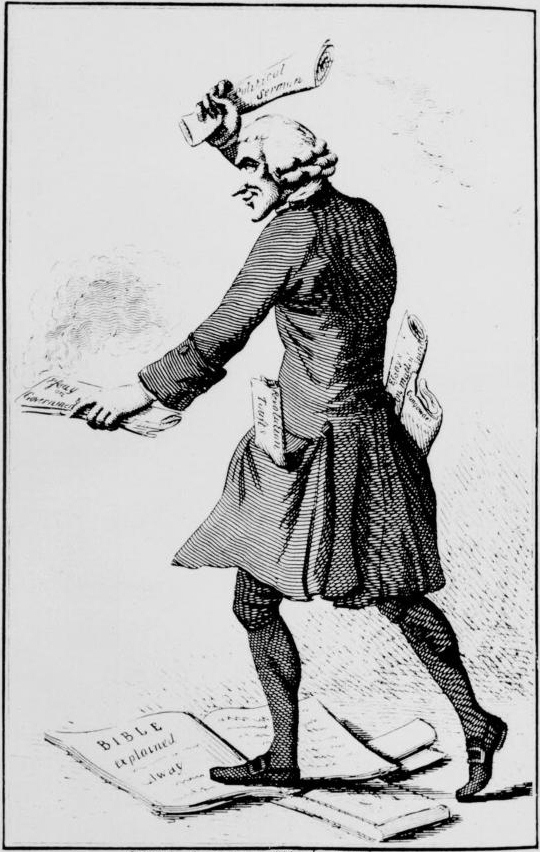MONTHLY BLOG 77, IDEAS TAKING A WRONG TURN
If citing, please kindly acknowledge copyright © Penelope J. Corfield (2017)
 Meditating about ideas taking a wrong turn (there are a lot of wrong turns around), I was reminded of the eighteenth-century saga of phlogiston – or the spirit of fire. It was a concept that held sway in scientific circles for many years, before it was found to be wrong. Not fruitfully wrong, stimulating fresh research and new developments. Just simply erroneous – in intellectual terms, a wrong turning.
Meditating about ideas taking a wrong turn (there are a lot of wrong turns around), I was reminded of the eighteenth-century saga of phlogiston – or the spirit of fire. It was a concept that held sway in scientific circles for many years, before it was found to be wrong. Not fruitfully wrong, stimulating fresh research and new developments. Just simply erroneous – in intellectual terms, a wrong turning.
There may be similarly erroneous ideas around in science today: superstring theories in theoretical physics,1 for example, or ‘dark matter’ in astro-physics (let alone ‘dark energy’ and/or ‘dark electromagnetism’).2 Such big concepts are intriguing ‘fillers’, often triggering intense debates. They fill a gap in knowledge, where there is perceived to be a problem but, as yet, no research-based solution with an accompanying explanatory theory. Sometimes such ideas are later empirically substantiated. Equally, however, sometimes not.
In the case of phlogiston, seventeenth- and eighteenth-century scientists were keen to understand what happens in the process of combustion. Some large logs are burned – and all that is left is a small pile of ashes. Hence one apparently logical answer was that combustion had released into the atmosphere a fiery element, almost like the spirit of fire itself, which, once freed, was released into the air. Substances that burned easily were full of this ignitable matter. The idea was formulated in 1667 by a German alchemist and physician, Johann Joachim Becher; and developed in 1703 by his former student Georg Ernst Stahl, a professor of medicine and chemistry. He was not the first to coin the term phlogiston, derived from the Greek for ‘inflaming’; but his analysis propelled the term into scientific currency.3
Research doubts, however, began eventually to circulate. Not all physical matter was reduced in weight by combustion. Some metals did the contrary. But somehow the principle of phlogiston as the spirit of fire remained an attractive one. The term remained widely in use among the developing community of researchers in Britain and France. Thus when in 1772 the Scottish chemist and botanist Daniel Rutherford4 managed to isolate and identify nitrogen as a separate gas, he named it ‘phlogisticated air’ (burnt air). The Nonconformist minister-cum-experimental-scientist Joseph Priestley was another who accepted the concept of phlogiston. In his path-breaking explorations of the composition of air, he was one of the first to identify oxygen as a gas. But he stuck with the old vocabulary, calling it ‘dephlogisticated air’. Accordingly, when Priestley was satirised for his radical political ideas, he was shown by the cartoonist as the fiery Dr Phlogiston – trampling underfoot the Bible, whilst simultaneously igniting the laws of England.5

|
Satirical print of Priestley as Dr Phlogiston: |
However, chemical theories and practice changed fundamentally after 1778. The French chemist Antoine-Laurent de Lavoisier (1743-94) not only identified and named ‘oxygen’ but also showed its key role as an oxidizer during combustion. There was no spirit of fire waiting to be released into the cosmos. References to phlogiston still lingered but were increasingly sidelined. Quietly, the entire theory behind the concept was dropped.6 Lavoisier also identified and named hydrogen (1783).7 The study of chemistry was advanced onto a new footing, aided by the increasingly international pooling of research. Henceforth ‘Air’ was not just air; and ‘Fire’ was not just fire.
Now phlogiston is known in the scientific lexicon as a category error. It commanded belief for a surprising amount of time, despite research doubts. But the concept did not lead to any interesting intellectual outcomes. It held sway and then quietly vanished.
Three morals for later generations. Firstly, there is often a hidden romantic idea (like the spirit of fire) or a cosmic vision behind apparently coldly rationalistic scientific concepts. Secondly, theories, even if very widely and genuinely accepted, remain no more than theories, until they are tested and confirmed empirically. Big organising ideas may become adopted because they are plausible or useful or powerful or attractive. Yet they don’t become world beaters, until they are verified. Thirdly and lastly, wrong turnings make for easy walking, until they suddenly don’t. Maybe that last proposition applies not only in the realm of ideas but in today’s politics too.
1 Compare B.R. Greene, The Elegant Universe: Superstrings, Hidden Dimensions, Theory, and the Quest for the Ultimate Theory (1999); and L. Smolin, The Trouble with Physics: The Rise of String Theory, the Fall of a Science, and What Comes Next (Boston, 2006).
2 R.H. Sanders, The Dark Matter Problem: A Historical Perspective (Cambridge, 2010).
3 J.H. White, The History of Phlogiston Theory (1932).
4 For Daniel Rutherford (1749-1819), see wikipedia.org/wiki/Daniel_Rutherford.
5 For Joseph Priestley (1733-1804), see R.E. Schofield, The Enlightenment of Dr Priestley: A Study of his Life and Work from 1733-73 (Philadelphia, 1997); idem, The Enlightened of Dr Priestley: A Study of his Life and Work from 1773-1804 (Philadelphia, 2004).
6 J.B. Conant (ed.), The Overthrow of the Phlogiston Theory: The Chemical Revolution of 1775-89 (Harvard, Mass., 1950).
7 F.L. Holmes, Antoine Lavoisier – The Next Crucial Year: Or, the Sources of his Quantitative Method in Chemistry (Princeton, 1998); J. Jackson, A World on Fire: A Heretic, an Aristocrat and the Race to Discover Oxygen (New York, 2005).
For further discussion, see Twitter
To read other discussion-points, please click here
To download Monthly Blog 77 please click here

